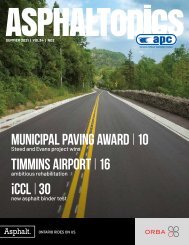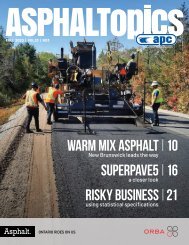ASPHALTopics | Summer 2020 | VOL 33 | NO 2
ASPHALTopics is the official publication of the Ontario Asphalt Pavement Council - A Council of the Ontario Road Builders' Association. Articles within ASPHALTopics may not be republished without express permission from OAPC.
ASPHALTopics is the official publication of the Ontario Asphalt Pavement Council - A Council of the Ontario Road Builders' Association. Articles within ASPHALTopics may not be republished without express permission from OAPC.
- No tags were found...
Create successful ePaper yourself
Turn your PDF publications into a flip-book with our unique Google optimized e-Paper software.
TECHNICALLY
SPEAKING
Doubra C. Ambaiowei
Technical Director
Encourage mixes that have higher
AC content — Top 10 List No. 2
Improvements in both aggregate quality and requirements,
as well as a performance-based testing and grading system
for asphalt binders, have played a major role in addressing
asphalt pavement performance problems. However, with
some of the methodologies that have been adopted, many
agencies are beginning to see the “balance” tip too far in
the other direction, and are experiencing asphalt pavement
durability problems. The durability of an asphalt pavement
is its ability to resist factors such as aging of the asphalt,
disintegration of the aggregate and stripping of the asphalt
film from the aggregates.
Asphalt pavements perform well when they are designed,
produced and constructed to provide desired properties
such as durability, impermeability, strength, stability,
stiffness, flexibility, fatigue resistance, and workability.
While these desired properties will vary depending on
purpose and other project requirements, it is an established
fact that the overall objective in the design of any asphalt
paving mix requires economic determination of an
appropriate blend of aggregate sources to produce
proper gradation of mineral aggregates and selecting
the type and amount of asphalt cement (AC) that yields
a mix with 1 :
• sufficient asphalt to ensure durable pavement;
Low AC content results in fatigue cracking, dryness or
ravelling and a brown dull pavement appearance, while
excess AC content leads to bleeding, fat spots and low skid
resistance. For virgin mixes, low AC contents are typically
caused by one of the following:
• asphalt absorption problems
• increase in dust content, thus decreasing VMA
• the loss of VMA during production and thus decreasing
the AC content to meet the air voids requirement
• production automation problems: pumps, weigh bridge,
asphalt meter, aggregate moisture, etc.
In recycled mixes, low AC contents can be caused by abovementioned
problems, but can also be related to:
• increased total dust percentages due to RAP fines,
thus decreasing VMA
• improper RAP proportions due to inaccurate RAP
moisture content
• high moisture contents in RAP, hampering the softening
of the RAP binder required to blend with virgin binder,
thus coating “black rocks” and reducing the total binder
content for the recycled mix
1
MS-2. “Asphalt Mix Design Methods — Asphalt Institute Manual Series, 7 th Edition”. 2014.
2
ORBA — Quality of Asphalt Review, KPMG LLP August 2018.
3
ORBA — A Review of Ontario Asphalt Industry Practices, TTI - Final Report, August 2018.
40 OAPC | ASPHALTOPICS


















